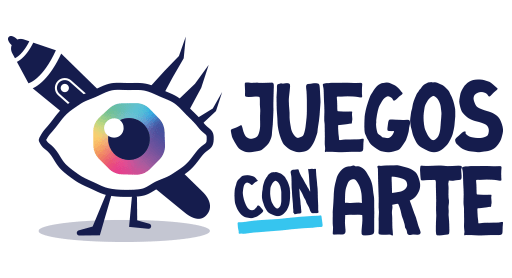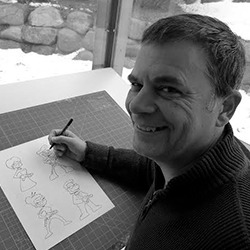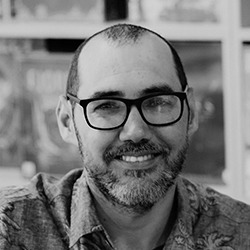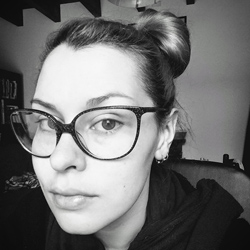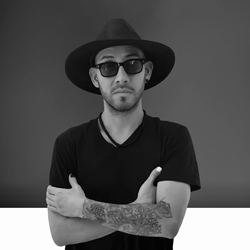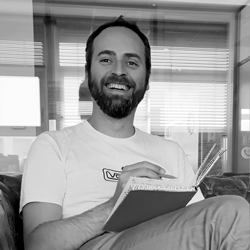
Jonathan Aucomte es uno de los ilustradores franceses más sobresalientes del sector de los juegos de mesa y en Juegos con Arte valoramos mucho su trabajo. Prueba de ello es el arte de Peek-a-Mouse uno de los juegos más originales que hemos visto y que han traído al castellano Mebo Games bajo el nombre de Casa Secreta.
Os dejamos con la entrevista de Jonathan y su magnífico arte.
ENG | Welcome Jonathan, for the readers who don’t know your great work in this sector, could you tell us a bit about yourself and your beginnings in the world of illustration?
Hi, I’m a french illustrator, based in the south of France. I’ve been working as a professional since 2008. At the beginning of my career, I was mainly doing commercial illustration and graphic design. But in 2015 I had the opportunity to work in the board game industry and never left. I’ve been working on 18 games since then and more to come. Beside board game art, I’m also working on a 3 volumes comic book for a french publisher named Drakoo.
ESP | Bienvenido Jonathan, para los lectores que no conocen tu gran trabajo en este sector, ¿podrías hablarnos un poco de ti y de tus inicios en el mundo de la ilustración?
Hola, soy un ilustrador francés, afincado en el sur de Francia. Llevo trabajando como profesional desde 2008. Al principio de mi carrera, hacía principalmente ilustración comercial y diseño gráfico. Pero en 2015 tuve la oportunidad de trabajar en la industria de los juegos de mesa y nunca lo dejé. He trabajado en 18 juegos desde entonces y más por venir. Además del arte de los juegos de mesa, también estoy trabajando en un cómic de 3 volúmenes para una editorial francesa llamada Drakoo.
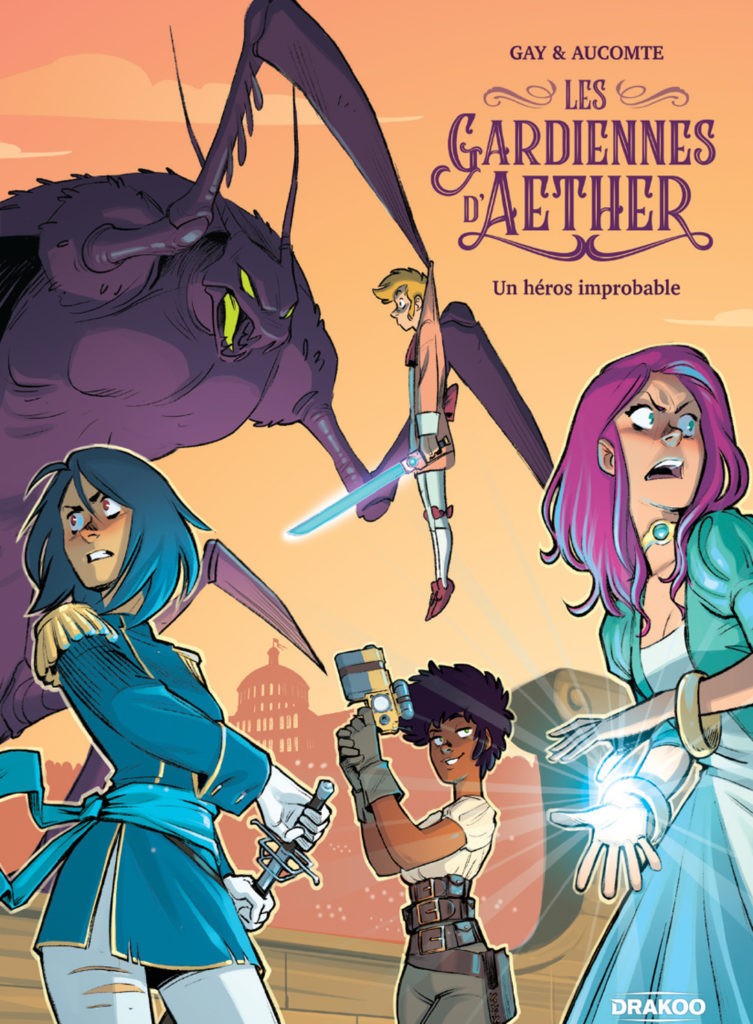
ENG | How did you first get involved in illustrating a board game and what did you learn from that project?
In 2014/15, I went to the international board game festival in Cannes (France) with my portfolio begging for work. Spoiler: I didn’t sign any contract, but I got a lot of advice and a warm and genuine welcome, which motivated me even more to work in this industry. I went back home and applied all the tips people gave me, which led me to completely rework my portfolio. I spent one year drawing as much as I could and went back to Cannes and it must have been good enough because this time I got a job. My first game was POW ! from Reiner Knizia, published by Gigamic.
I really enjoyed the process, I was like a child who was allowed to draw anything he wanted, but paid, a dream come true ! I had to imagine a bunch of funny superheroes. I was not very aware of board games by then, I didn’t play that much. So I didn’t really think of the gameplay and the way my pictures would be seen in the context of a game. I painted the picture at full screen, high resolution on my tablet, spending a lot of time on details. But the tiles are really small in reality, and I realized I spent way too much time on my pictures. Now I focus on the efficiency of the picture: what impression will it make on the table, how will people see it and play with it. I try to find a good balance between the amount of details and the impact of the picture.
ESP | ¿Cómo te involucraste por primera vez en la ilustración de un juego de mesa y qué aprendiste de ese proyecto?
En 2014/15, acudí al festival internacional de juegos de mesa de Cannes (Francia) con mi portafolio rogando por trabajo. Spoiler: No firmé ningún contrato, pero recibí muchos consejos y una acogida cálida y genuina, lo que me motivó aún más a trabajar en esta industria. Volví a casa y apliqué todos los consejos que la gente me dio, lo que me llevó a rehacer completamente mi portafolio. Pasé un año dibujando todo lo que pude y volví a Cannes, y debió de ser lo suficientemente bueno porque esta vez conseguí un trabajo. Mi primer juego fue POW! de Reiner Knizia, publicado por Gigamic.
Disfruté mucho del proceso, era como un niño al que se le permitía dibujar lo que quisiera, pero pagado, ¡un sueño hecho realidad! Tuve que imaginar un montón de superhéroes divertidos. Por aquel entonces no estaba muy al tanto de los juegos de mesa, no jugaba mucho. Así que no pensé realmente en la jugabilidad y en la forma en que mis imágenes se verían en el contexto de un juego. Pinté el cuadro a pantalla completa y en alta resolución en mi tableta, dedicando mucho tiempo a los detalles. Pero las baldosas son realmente pequeñas en la realidad, y me di cuenta de que dedicaba demasiado tiempo a mis imágenes. Ahora me centro en la eficacia de la imagen: qué impresión causará en la mesa, cómo la verá la gente y jugará con ella. Intento encontrar un buen equilibrio entre la cantidad de detalles y el impacto de la imagen.
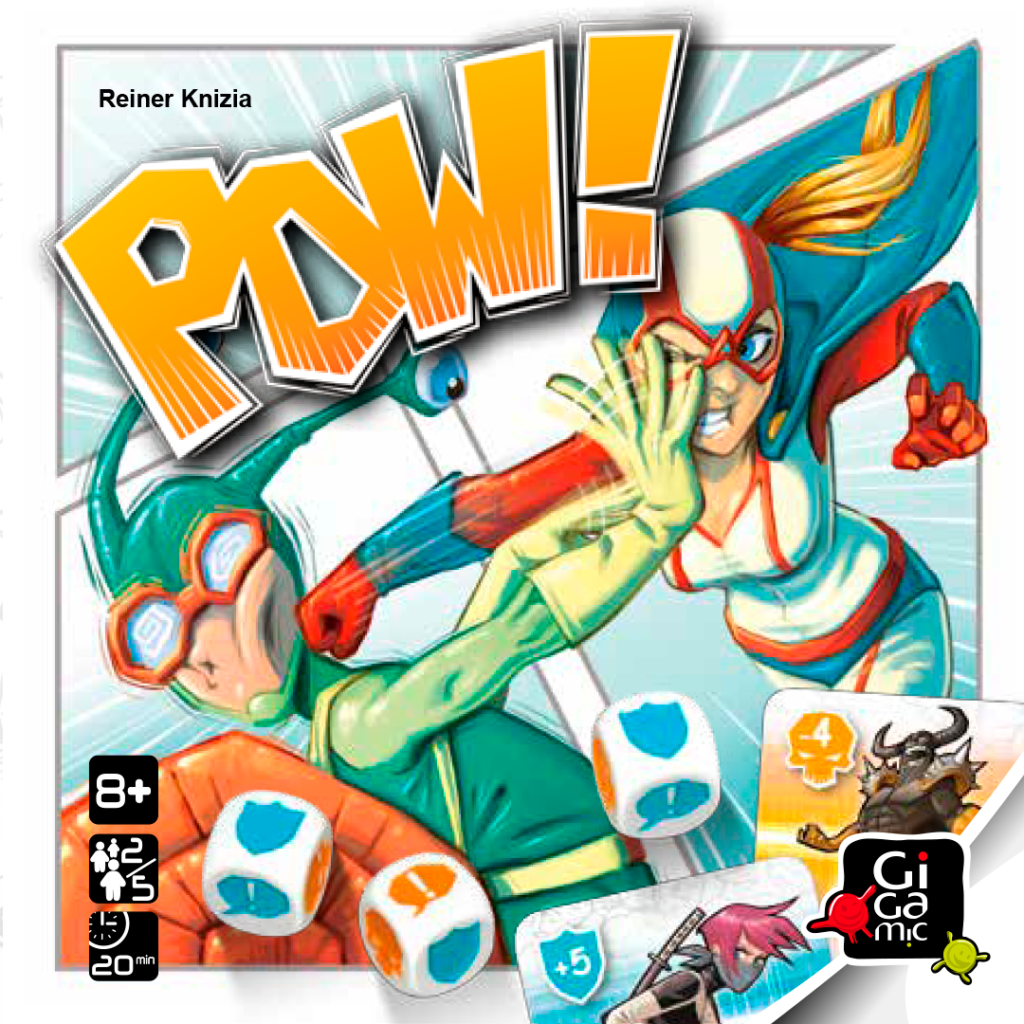
ENG | We want to highlight your work on one of your latest board games Peek-a-Mouse, in Spanish translated as «Casa Secreta». How was the experience of illustrating such an original game?
Gigamic called me and told me they had 2 projects for me, and I had to choose. They explained to me the concept of Peek-a-Mouse with a few words, and I was instantly hooked. I don’t remember what the second project was, I said immediately yes for this one. I knew there was something special about it just by hearing the description. At first the concept was to do a small version of a witch house.
Then, somebody at Gigamic came up with the idea of a real size house….for a mouse family ! It was very smart and led to a lot of cool ideas to develop. I started by sketching some ideas. I sent these pictures below to Gigamic and had very positive feedback: everybody was hyped, that was it, that would be the starting point of the project.
ESP | Queremos destacar tu trabajo en uno de tus últimos juegos de mesa Peek-a-Mouse, en español traducido como «Casa Secreta». ¿Cómo fue la experiencia de ilustrar un juego tan original?
Gigamic me llamó y me dijo que tenían 2 proyectos para mí, y que tenía que elegir. Me explicaron el concepto de Peek-a-Mouse con unas pocas palabras, y me enganché al instante. No recuerdo cuál era el segundo proyecto, pero dije inmediatamente que sí para éste. Sabía que tenía algo especial sólo con escuchar la descripción. Al principio el concepto era hacer una versión pequeña de una casa de brujas.
Luego, a alguien de Gigamic se le ocurrió la idea de una casa de tamaño real …. para una familia de ratones. Fue muy inteligente y dio lugar a un montón de ideas geniales para desarrollar. Empecé por dibujar algunas ideas. Envié estas fotos a Gigamic y tuve una respuesta muy positiva: todo el mundo estaba entusiasmado, eso era todo, ese sería el punto de partida del proyecto.

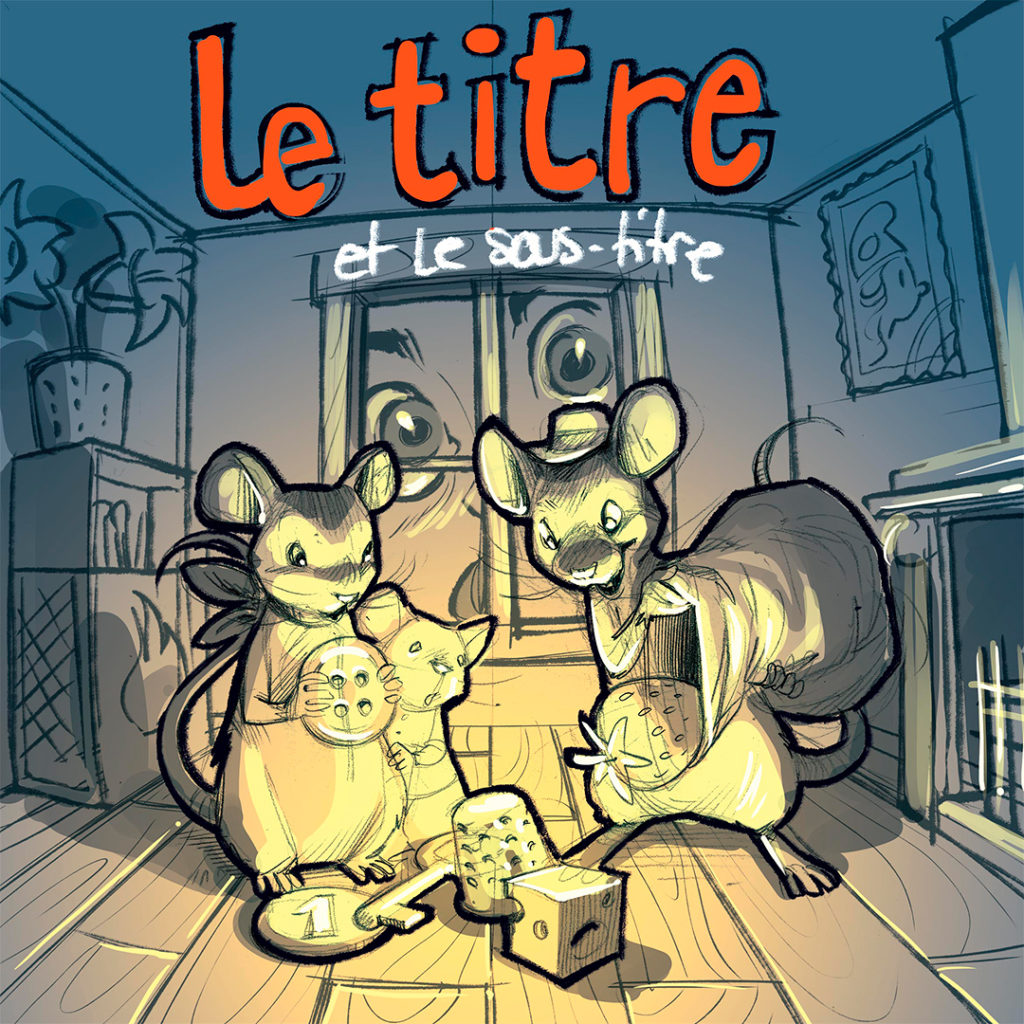
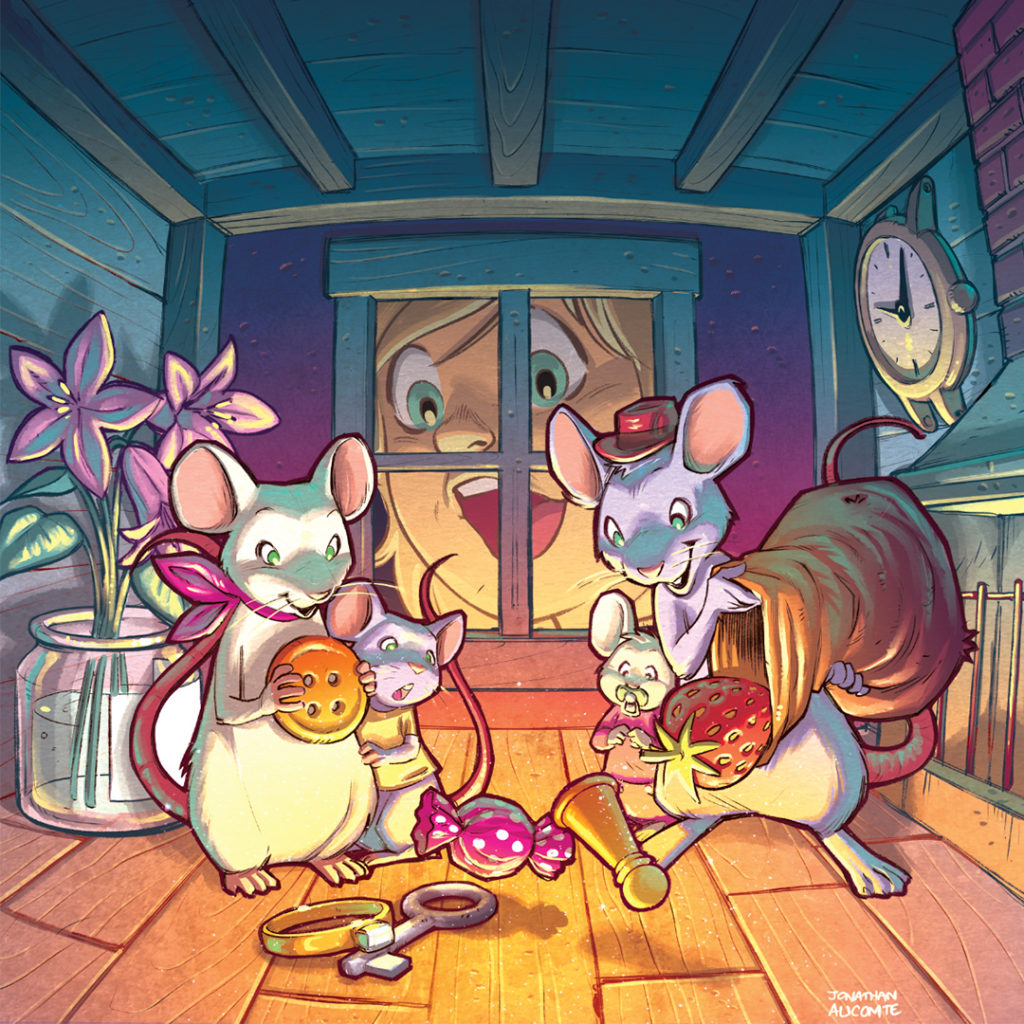
ENG | How was the creative process for the creation of the Peek-a-Mouse artwork? Tell us about that process, from the first idea or purpose to the final artwork.
It was a lot of fun but quite difficult too ! It’s a complicated project, hard to manufacture and the attention to details was really high.
The difficult part is that, when I drew, I couldn’t see the final result and wondered all the time: will it work ? Will there be enough details ? Too Much ? Will people recognise the rooms ? Will there be enough light to see the picture?
So I tried to put everything into perspective to ensure that the environment will be ok (see sketches below). When I saw the first prototypes I was relieved: it worked very nicely.
My main inspirations were my daughter and the movie Arrietty. I was always thinking of how she would play with this house, her surprise discovering this universe, the little details… And Arrietty has such a lovely ambiance, the attention to details makes it very believable, that’s what I wanted too.
ESP | ¿Cómo fue el proceso creativo para la creación del arte de la Casa Secreta? Háblenos de ese proceso, desde la primera idea o propósito hasta la obra de arte final.
Fue muy divertido, pero también bastante difícil. Es un proyecto complicado, difícil de fabricar y la atención a los detalles fue realmente alta.
Lo difícil es que, cuando dibujaba, no podía ver el resultado final y me preguntaba todo el tiempo: ¿funcionará? ¿Habrá suficientes detalles? ¿Demasiados? ¿Reconocerá la gente las habitaciones? ¿Habrá suficiente luz para ver el dibujo?
Así que intenté ponerlo todo en perspectiva para asegurarme de que el entorno estaría bien (véanse los bocetos más abajo). Cuando vi los primeros prototipos me sentí aliviado: funcionaba muy bien.
Mis principales inspiraciones fueron mi hija y la película Arrietty. Siempre pensaba en cómo jugaría ella con esta casa, su sorpresa al descubrir este universo, los pequeños detalles… Y Arrietty tiene un ambiente tan bonito, la atención a los detalles lo hace muy creíble, eso es lo que yo quería también.
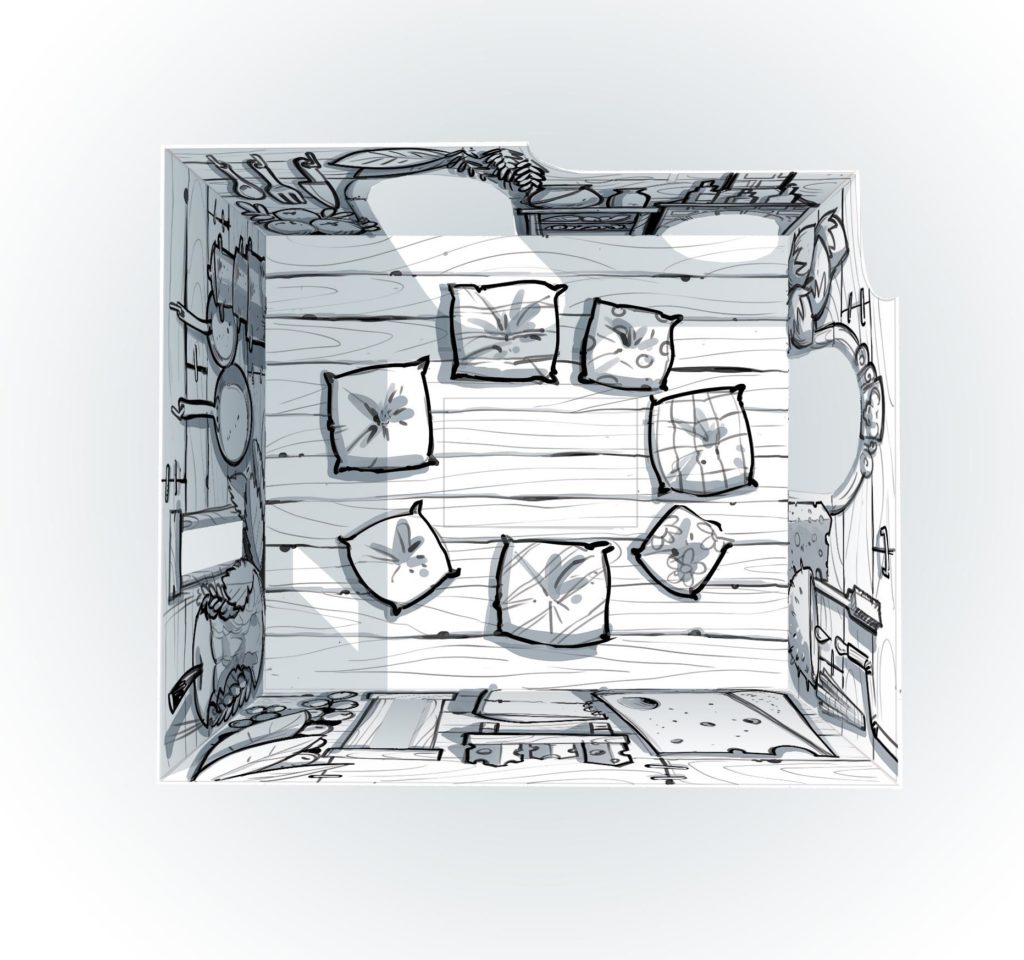
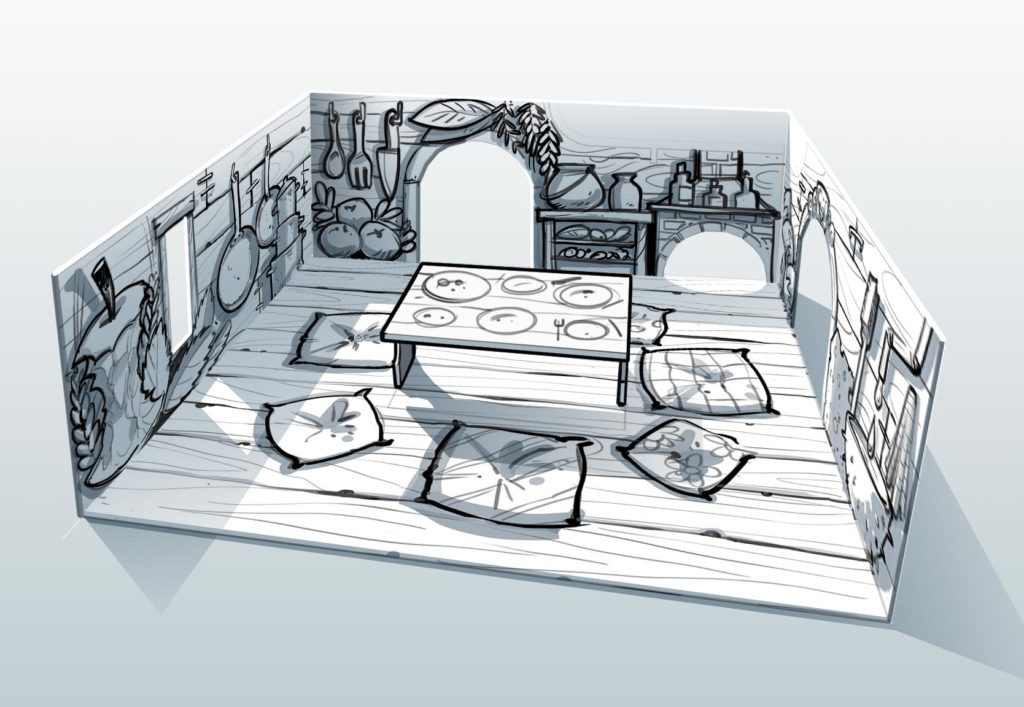
ENG | What challenges or peculiarities arose during the creation process?
Adjustments all the time. There was a lot of back & forth in order that everything came into place. It was a matter of a single millimeter sometimes. But I had the chance to work with a very efficient project manager: Delphine Brennan. She was alway anticipating problems and the good communication between us helped to manage all of it. That’s something super important: the people who you work with can make it either easy or a total nightmare, both sides. That’s an important thing to know about this industry: you always work as a team, so you better be good at listening and communicating, it’s not just a matter of being a good artist.
ESP | ¿Qué retos o peculiaridades surgieron durante el proceso de creación?
Ajustes todo el tiempo. Hubo muchas idas y venidas para que todo estuviera en su sitio. A veces era cuestión de un solo milímetro. Pero tuve la oportunidad de trabajar con una directora de proyecto muy eficiente: Delphine Brennan. Siempre se anticipaba a los problemas y la buena comunicación entre nosotros ayudó a gestionarlo todo. Eso es algo super-importante: la gente con la que trabajas puede hacer que sea fácil o una auténtica pesadilla, en ambos lados. Eso es algo importante que hay que saber sobre esta industria: siempre se trabaja en equipo, así que más vale ser bueno escuchando y comunicando, no se trata sólo de ser un buen artista.



ENG | When you illustrate a board game, the art and design must be adapted to the gameplay and usability of the game. Could you give our readers 3 tips that you consider key to illustrate a board game?
1: Draw for the sake of the game, not just to please yourself. Your pictures must work in the context of the game, not just being beautiful.
2: Beware of the size of the pictures you’re working on ! It’s not a movie poster, it’s playing cards, tiles, coins etc. It’s really small. Try to work as close to the original size as you can.
3: Do your stuff, don’t try to emulate other’s style: there’s already a lot of super talented, high standard artists in this industry. Publishers sometimes search for something different, if your style is unique, it will stand out.
ESP | Cuando se ilustra un juego de mesa, el arte y el diseño deben adaptarse a la jugabilidad y la usabilidad del juego. ¿Podría dar a nuestros lectores 3 consejos que considera clave para ilustrar un juego de mesa?
1: Dibuja por el bien del juego, no sólo para complacerte a ti mismo. Tus dibujos deben funcionar en el contexto del juego, no sólo ser bonitos.
2: ¡Cuidado con el tamaño de los dibujos que estás trabajando! No es un cartel de cine, son cartas, fichas, monedas, etc. Es realmente pequeño. Intenta trabajar lo más cerca posible del tamaño original.
3: Haz lo tuyo, no intentes emular el estilo de otros: ya hay muchos artistas de gran talento y nivel en esta industria. Los editores a veces buscan algo diferente, si tu estilo es único, destacará.
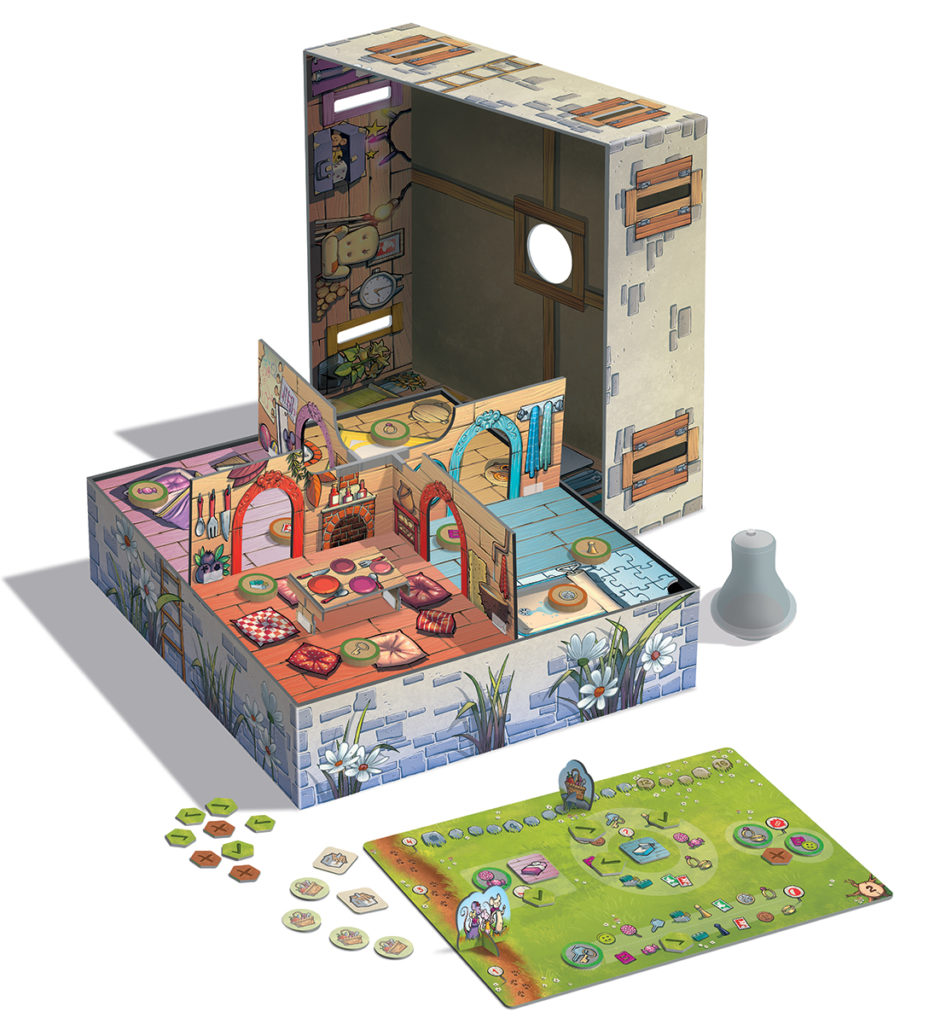
ENG | You are also responsible for the art of Gold River, what was the inspiration and process for the creation of the characters and locations that appear in the game?
Antoine Roffe, who leads Lumberjacks Studio, is very open minded. He trusted me and let me test some things, artistically. I had the opportunity to experiment on my illustration, and believe me, it doesn’t happen so often. For example, if you look closely, you’ll see that the sketch is still visible, not covered by the colors. That gives a special vibe to the pictures. For inspiration, I did some research of this period and let myself draw freely in my sketchbook. It was an already existing game, so I had to kind of stick to the original vibe, but adding a modern impression. I really love that game, I’m proud of the result, it’s one of my favorites.
ESP | También eres responsable del arte de Gold River, ¿en qué te has inspirado y cuál ha sido el proceso de creación de los personajes y las localizaciones que aparecen en el juego?
Antoine Roffe, que dirige el estudio Lumberjacks, tiene una mentalidad muy abierta. Confió en mí y me dejó probar algunas cosas, artísticamente. Tuve la oportunidad de experimentar en mi ilustración, y créanme, no ocurre muy a menudo. Por ejemplo, si te fijas bien, verás que el boceto sigue siendo visible, no está cubierto por los colores. Eso da un aire especial a las imágenes. Para inspirarme, investigué un poco sobre esta época y me permití dibujar libremente en mi cuaderno de bocetos. Era un juego que ya existía, así que tuve que ceñirme al ambiente original, pero añadiendo una impresión moderna. Me encanta ese juego, estoy orgulloso del resultado, es uno de mis favoritos.
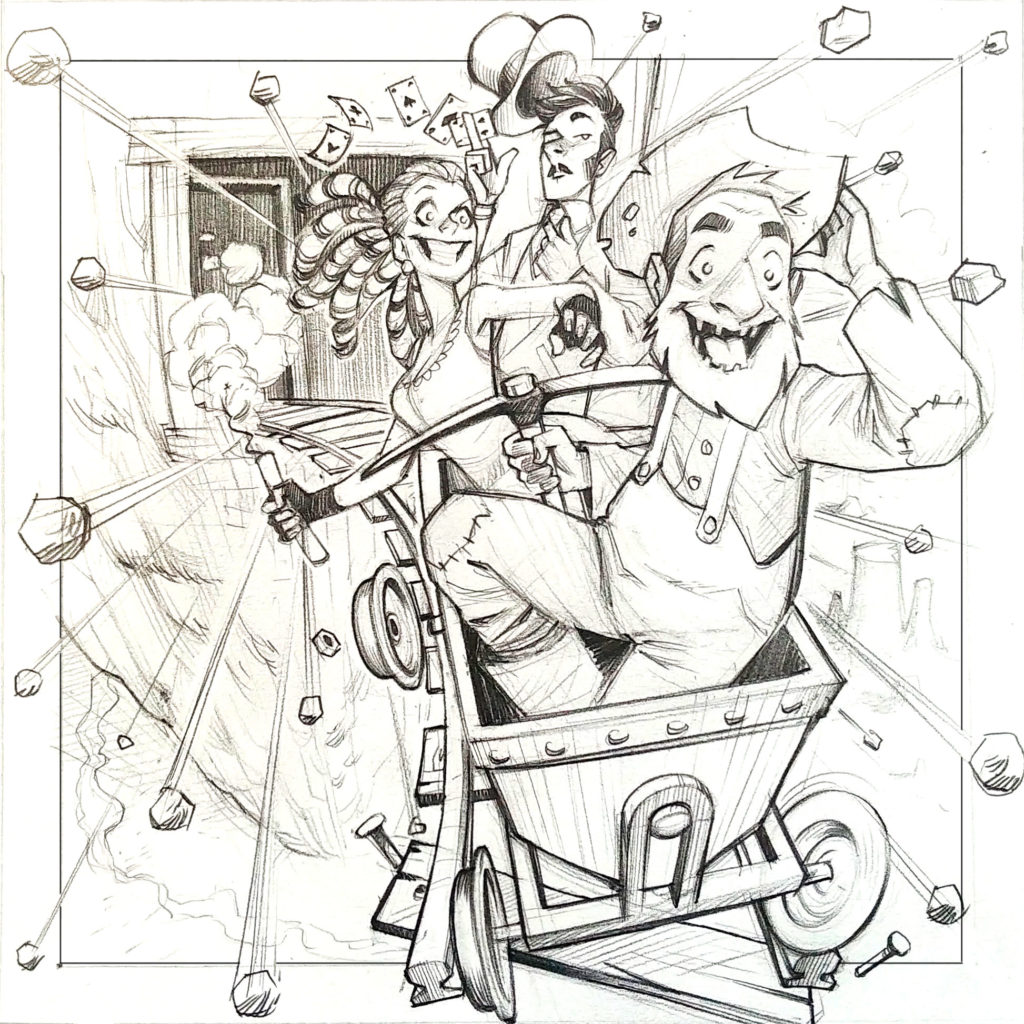
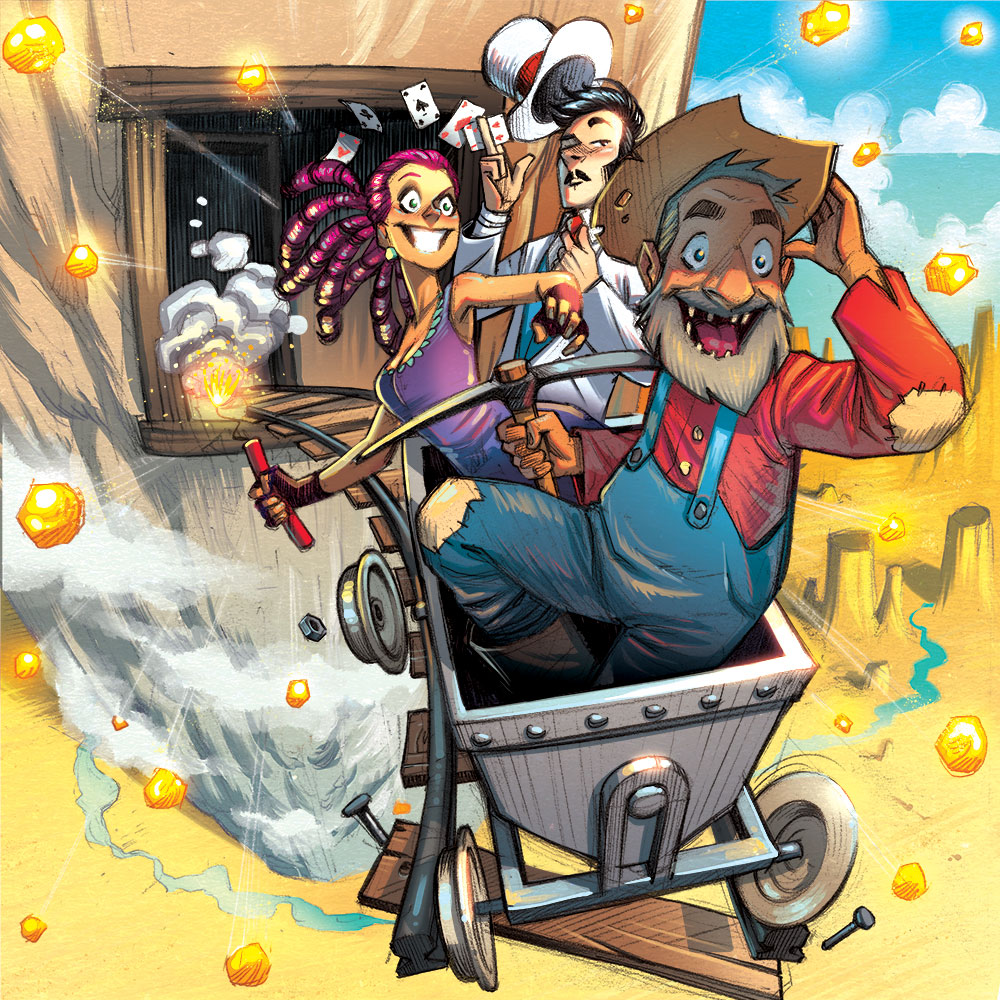
ENG | We would like to finish talking about the art of one of your latest board games Audimat, about which we still don’t have much information. What can you tell us about the project and how was the experience of illustrating it?
I‘ve been approached by Bragelonnes Games to work on this serie of games named «For The Story». They wanted to make something related to reality shows and thought my style would fit, the cartoon aspect of it. We played the game online and I was hyped by concept. You build your own story by answering questions that guide the players, so every story is unique, it depends of imagination. The team at Bragelonne was always listening to my suggestions and the result has something special I think. It ended up there is no cartoon style at all in it. It a little different than what I usually do, I’m curious to see if people will like it.
ESP | Nos gustaría terminar hablando del arte de uno de tus últimos juegos de mesa Audimat, del que aún no tenemos mucha información. ¿Qué puedes contarnos sobre el proyecto y cómo fue la experiencia de ilustrarlo?
Bragelonnes Games se puso en contacto conmigo para trabajar en esta serie de juegos llamada «For The Story». Querían hacer algo relacionado con los reality shows y pensaron que mi estilo encajaría, el aspecto de dibujos animados. Jugamos al juego online y me entusiasmó el concepto. Construyes tu propia historia respondiendo a las preguntas que guían a los jugadores, así que cada historia es única, depende de la imaginación. El equipo de Bragelonne estuvo siempre atento a mis sugerencias y creo que el resultado tiene algo especial. Al final no hay ningún estilo de dibujos animados en él. Es un poco diferente de lo que suelo hacer, tengo curiosidad por ver si a la gente le gusta.

ENG | To finish the interview, what projects are you currently working on?
I’m spending most of my time on my comic book «Les Gardiennes d’Aether», written by Olivier Gay and published in France by Drakoo. I just finished the second volume. I’ll take some rest before starting the third one, because that’s a lot of work!
Moreover, I illustrated the new design of «Marrakech» which will be out soon I think and there’s also this really cool game coming on at Gigamic, but I can’t tell much about it, just that it’s about birds :).
ESP | Para terminar la entrevista, ¿en qué proyectos está trabajando actualmente?
Estoy dedicando la mayor parte de mi tiempo a mi cómic «Les Gardiennes d’Aether», escrito por Olivier Gay y publicado en Francia por Drakoo. Acabo de terminar el segundo volumen. Me tomaré un descanso antes de empezar el tercero, ¡porque es mucho trabajo!
Además, he ilustrado el nuevo diseño de «Marrakech», que saldrá pronto, creo, y también hay un juego muy chulo en marcha en Gigamic, pero no puedo contar mucho sobre él, sólo que trata de pájaros :).
Muchas gracias Jonathan 😉
(Todas las imágenes cedidas por Jonathan Aucomte)

